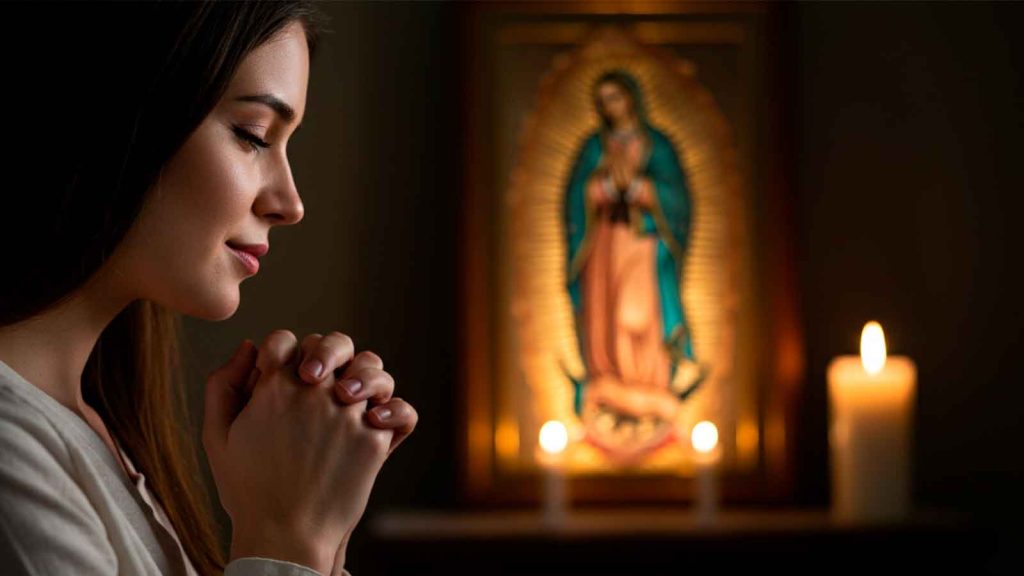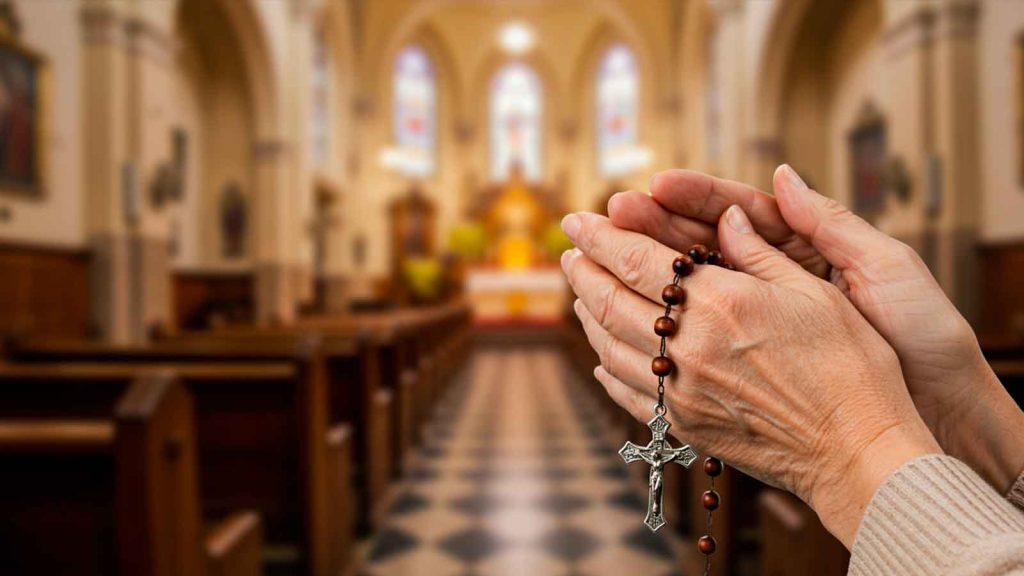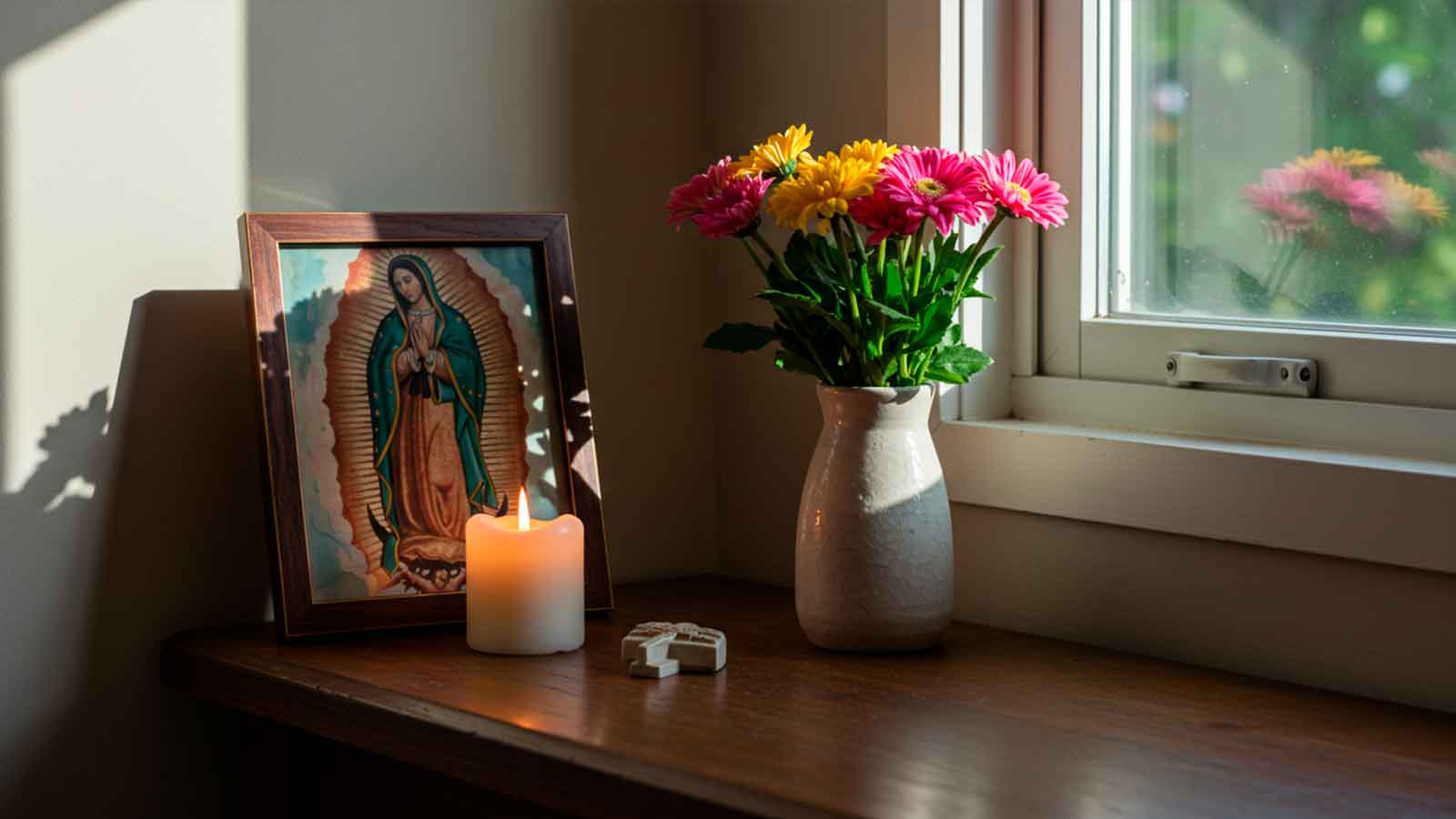The Hail Holy Queen full prayer is one of the most traditional and moving prayers of the Catholic faith. Over the centuries, this prayer has been a source of consolation, hope, and faith for millions of devotees around the world. Praying it is an act of trust in the intercession of Mary, mother of Jesus and spiritual mother of humanity. In this article, you will learn its origin, how to pray it, when to use it, and what it represents spiritually.
The Hail Holy Queen Full Prayer
Below is the Hail Holy Queen full prayer as traditionally recited by the faithful:
Hail, Holy Queen, Mother of mercy, our life, our sweetness and our hope, hail!
To you do we cry, poor banished children of Eve.
To you do we send up our sighs, mourning and weeping in this valley of tears.
Turn then, most gracious advocate, your eyes of mercy toward us.
And after this exile show unto us Jesus, the blessed fruit of your womb.
O clement, O loving, O sweet Virgin Mary.
Pray for us, O Holy Mother of God,
that we may be made worthy of the promises of Christ.
Amen.
This version of the Hail Holy Queen full prayer is used at Mass, at the end of the rosary, and also in moments of personal prayer. Its poetic language conveys profound feelings of faith, hope, and the search for consolation.
Explanation of the Hail Holy Queen Prayer
Hail, Holy Queen, Mother of mercy, our life, our sweetness and our hope, hail!
Explanation:
This opening salutation is a praise to the Virgin Mary, recognizing her spiritual queenship as Queen of Heaven. She is called Mother of mercy because she is seen as the intercessor who welcomes sinners with compassion. By calling her life, sweetness, and hope, the faithful express total confidence in her maternal love, capable of leading hearts to Christ.
To you do we cry, poor banished children of Eve.
Explanation:
Here we acknowledge our human condition: we are children of Eve, expelled from paradise and marked by the consequences of original sin. “Cry” means to call out with force, imploring the help of the heavenly Mother amid the difficulties of this life.
To you do we send up our sighs, mourning and weeping in this valley of tears.
Explanation:
Earthly life is described as a valley of tears, an expression representing suffering, pain, and tribulations. The sighs, mourns, and tears reflect the afflicted heart of the faithful who seeks consolation and spiritual protection in Mary.
Turn then, most gracious advocate, your eyes of mercy toward us.
Explanation:
Here the faithful recognize Mary as an advocate, the one who intercedes for us before God. The request is that she turn her eyes—full of mercy—toward us, that is, that she look with tenderness and compassion upon our sorrows and needs.
And after this exile show unto us Jesus, the blessed fruit of your womb.
Explanation:
“Exile” refers to life in this world, far from the heavenly homeland. The prayer asks that, at the end of our earthly journey, Mary lead us to the full vision of Jesus, the blessed fruit of her womb, the promised Savior. This is the culmination of Christian hope.
O clement, O loving, O sweet Virgin Mary.
Explanation:
These three adjectives—clement, loving, and sweet—exalt Mary’s qualities: her clemency (kindness), her mercy (compassionate love), and her sweetness (maternal tenderness). The repetition intensifies praise and devotion.
Pray for us, O Holy Mother of God,
Explanation:
This plea asks for Mary’s constant intercession before God. By calling her Holy Mother of God, we recognize her unique role in salvation history: being the mother of the Savior Himself.
that we may be made worthy of the promises of Christ.
Explanation:
The final request is that, with Mary’s help, we may be worthy to receive the promises of Christ—which include salvation, eternal life, and the Kingdom of God. It is a plea for holiness and perseverance in faith.
Amen.
Explanation:
The word “Amen” means “so be it.” With it, the faithful confirm everything that has been prayed with faith and trust. It is a reverent, affirmative conclusion, sealing the prayer with spiritual conviction.

The Historical Origin of the Hail Holy Queen Prayer
The Hail Holy Queen full prayer arose around the 11th century. It is attributed to the Benedictine monk Hermann of Reichenau, who, despite severe physical limitations, composed this beautiful prayer. Since then, it has been adopted in Catholic liturgy and has become one of the four traditional Marian antiphons.
A devotion that spans the centuries
During the Middle Ages, the Hail Holy Queen full prayer gained popularity among the faithful and began to be prayed frequently in monasteries, churches, and Christian homes.
When to Pray the Hail Holy Queen
At the end of the rosary
The Hail Holy Queen full prayer is recited right after the five decades of the rosary, as a form of closure and final supplication.
Moments of sorrow and tribulation
In times of suffering, the prayer is a source of comfort and a way to trust in Mary’s intercession.
During retreats and spiritual gatherings
Widely used in communal moments of prayer, helping unite the faithful in praise and trust.

Spiritual Benefits of Praying the Hail Holy Queen
- Deepens Marian devotion
- Provides spiritual comfort
- Strengthens hope and faith
- Brings peace to the heart amid difficulties
The Hail Holy Queen full prayer is not just a recitation; it is an encounter with the maternal tenderness of Mary.
The Hail Holy Queen and the Rosary
The prayer’s role in the Rosary
The Hail Holy Queen full prayer concludes the Rosary, uniting the meditations on the life of Jesus with the invocation of His Mother.
Strengthening of faith
Praying the entire Rosary, including the Hail Holy Queen full prayer, helps keep the mind and heart focused on spirituality.
How to Teach the Hail Holy Queen to Children
Practical tips
- Break the prayer into small parts
- Repeat daily with patience
- Explain difficult words in simple terms
- Use images of Mary to aid understanding
Teaching the meaning
Show that the Hail Holy Queen full prayer is a conversation with a Mother who listens, welcomes, and intercedes.
Hail Holy Queen in Different Contexts
During Marian Masses
Celebrated on feasts such as the Assumption and Our Lady of Aparecida, the Hail Holy Queen full prayer is recited with special reverence.
At wakes and farewells
It is common to pray it in moments of mourning, asking the Virgin Mary’s intercession for those who have departed and for those who remain.
In novenas
The prayer also appears in Marian novenas, expressing trust in Mary’s care.

How to Create a Prayer Space at Home
Items that help devotion
- Image of the Virgin Mary
- Rosary
- Lit candle or fresh flower
- Holy Bible
This space can be reserved for daily prayer moments, especially to pray the Hail Holy Queen full prayer calmly and with faith.
Reflections After Praying the Hail Holy Queen
The Hail Holy Queen full prayer is not just a string of memorized words; it is an invitation to inner recollection, trust in Mary’s maternal intercession, and a sincere opening of the heart to God. After praying it, it is natural for thoughts and emotions to arise that deserve attention. Reflecting on what has been said helps internalize the prayer and allows it to transform, little by little, our way of living.
In which areas of my life do I most need God’s mercy?
This is an essential question for spiritual self-knowledge. The phrase “Mother of mercy” reminds us that God, through Mary, offers forgiveness and welcome even in the most fragile moments of our existence. When praying, it is important to sincerely recognize where there are wounds, recurring sins, fears, or doubts. These are the areas that most need divine mercy. The prayer becomes a starting point for seeking conversion, inner healing, and peace of mind.
How can I follow Mary’s example in my routine?
Mary is a model of humility, obedience, listening, and service. By praying the Hail Holy Queen full prayer, we are called to imitate her—not as a distant figure but as a real woman who lived her faith fully. We can reflect: am I being more patient with my family? Have I embraced life’s difficulties with trust? Have I said “yes” to God’s plans even when I do not understand everything? Bringing these questions into daily life makes the prayer a concrete inspiration for change.
To whom can I dedicate my prayer today?
Prayer need not be just a personal act. It can be offered for someone who is suffering, for a specific cause, or for souls in need. After finishing the Hail Holy Queen full prayer, it is worthwhile to pause for a few moments and think: who needs consolation today? Who asked me to pray? Who needs peace? By doing so, we extend the power of prayer, making it an act of love and solidarity.
A prayer that becomes an encounter
These reflections are practical ways to live what is prayed. When we do not merely repeat words but meditate on them, the Hail Holy Queen full prayer ceases to be merely a tradition and becomes a real encounter with God through Mary’s tenderness. Each plea, each verse, each request becomes dialogue, listening, and inner renewal.
To pray with the heart is to allow God to speak, heal, and transform—and Mary, as Mother, always guides us on this path.
Curiosities About the Hail Holy Queen
Featured in religious films
The prayer has appeared in memorable scenes of Catholic movies, reinforcing its symbolic power.
In Latin and Gregorian chant
The Salve Regina version is used in monasteries and more solemn celebrations, keeping the original tradition alive.
Linked to the lives of saints
Many saints reported comfort and miracles when praying the Hail Holy Queen full prayer, such as Saint Alphonsus Liguori and Saint Faustina.
FAQ – Frequently Asked Questions About the Hail Holy Queen
Can I pray the Hail Holy Queen full prayer outside the rosary?
Yes, you can pray it independently at any time of day.
Can children learn the prayer?
Absolutely. With simple explanations and practice, children can memorize and understand its meaning.
Is there an official version?
Yes, the most common version is the one presented at the beginning of this article, used by most Catholic communities.
Is it possible to sing the Hail Holy Queen?
Yes. There are several sung versions of the prayer, including Gregorian and popular styles.
Is the prayer obligatory?
It is not obligatory, but it is highly recommended for its spiritual value and tradition in the Catholic Church.
READ ALSO:
- Psalm 48: The Greatness of God Revealed in Zion
- Psalm 49: An Invitation to Reflect on True Wealth
- Psalm 47: Exaltation to the Supreme God Who Reigns Over the Whole Earth
- Psalm 45: A Royal Song of Love and Glory
FOLLOW US ON FACEBOOK
We hope you enjoyed it.
Leave your message of faith below!